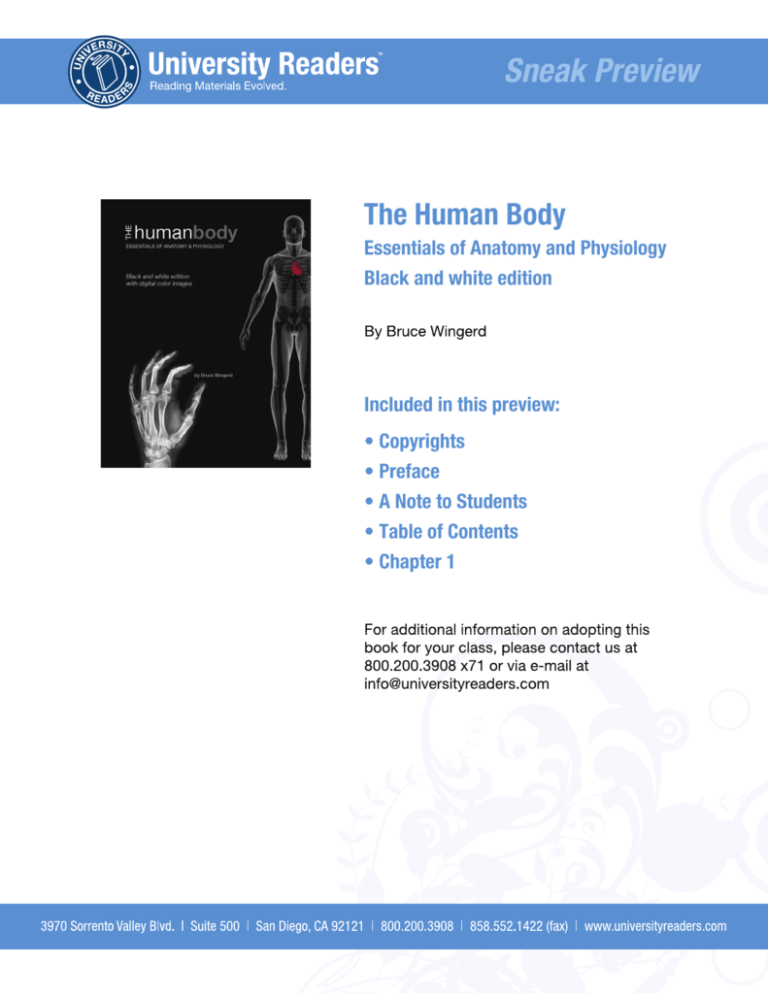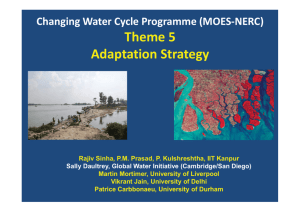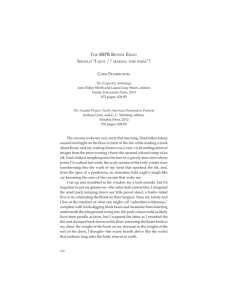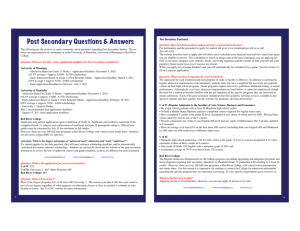
Sneak Preview
The Human Body
Essentials of Anatomy and Physiology
Black and white edition
By Bruce Wingerd
Included in this preview:
• Copyrights
• Preface
• A Note to Students
• Table of Contents
• Chapter 1
For additional information on adopting this
book for your class, please contact us at
800.200.3908 x71 or via e-mail at
info@universityreaders.com
THE HUMAN BODY
Essentials of Anatomy & Physiology
Second Color Edition
Bruce Wingerd
Bruce Wingerd is Associate Dean of Biology at Broward Community College in
Florida and previously taught at San Diego State University for 25 years. He has
taught human anatomy, advanced human anatomy, medical terminology, and
anatomy and physiology. Between his numerous writing projects, he has run
workshops on teaching anatomy and physiology for the benefit of local high
school and junior high school teachers.
Copyright © 2008 by Bruce Wingerd
All rights reserved. No part of this book may be reproduced or transmitted in any form or by any
means, electronic or mechanical, including photocopying, recording, or using any other
information storage and retrieval system, without permission in writing from the publisher.
First published in the United States of America in 2007 by University Readers
12 11 10 09 08
12345
Printed in the United States of America
The Human Body: Essentials of Anatomy and Physiology is a revised and condensed version of
The Human Body: Concepts of Anatomy and Physiology, first published by Brooks/Cole in 1994.
Illustration program provided courtesy of Thomson Learning and Jennifer Riggin.
ISBN: 978-1-934269-11-4 (paper)
A study guide along with full-color versions of all illustrations
are available to students enrolled in a class using this textbook.
Go to http://www.universityreaders/publish/wingerd/students
PREFACE
gling through the mountains of terminology in anatomy and
dents learn the essential information by using the process of
concept building. If a student is able to form a mental image
of a technical term’s meaning or a process, learning becomes
easier and lasts longer due to the mental connections that
or literal description, the student is encouraged to visualize
course, some memorizing is unavoidable, but providing stu-
mation and technologies.
THE APPROACH AND
MAIN THEME
Human anatomy and physiology is a challenging topic for
introductory-level learners, and mastering the material requires an investment of time and effort. The second edition
of The Human Body meets this challenge by providing an approach that encourages learning. The approach includes three
the aid of concept-building tools, and using the process of
of learning, the result can lead to personal and professional
Integrating Structure and Function
The Human Body: Concepts of Anatomy and Physiology
to make the book an even better tool for learning. Many sug-
book’s main approach is to establish a comfortable balance of
structure and function for the beginning student. At the outtion of a particular system. The more detailed information
ideas have arisen from the changes that have occurred in sciterms needed to fully understand and communicate function
are provided. Then function is described, using the buildingan improved learning tool for students. It remains my hope
discussion, the functional importance of a structure is emphasized.
Learning with Concept-Building Tools
The book’s approach is also based on the notion that learn-
NEW TO THE SECOND
EDITION
complete if a conceptual foundation is provided. Numerous
concept-building tools are employed to establish this foundation. Each tool enables a student to establish a mental image
-
in the original text, in addition to recognizing opportunities
The conceptual foundation is reinforced by logical explanageneral, this second edition is a more balanced text that inmore reader-friendly style. The level of information has been
terms added and others deleted. Explanations of many physi-
information, and many high-quality illustrations that correspond directly to the text material.
ii
Preface
The Theme of Homeostasis
The main theme of the text is the body’s remarkable ability to
PDLQWDLQKRPHRVWDVLV+RZWKHERG\DFKLHYHVKRPHRVWDVLV
despite changing conditions, the body components involved
in its maintenance, and the consequences of the body’s failXUHWRPDLQWDLQLWHIIHFWLYHO\DUHWRSLFVWKDWDUHLQWHUZRYHQ
throughout. In many chapters, the role of body tissues, organs, and systems in maintaining and supporting homeostasis
LVGLVFXVVHGDORQJZLWKWKHLURWKHUIXQFWLRQV7RHPSKDVL]H
the importance of homeostasis in the daily maintenance of
health, this vital body function is also presented as a separate
topic at the end of most chapters. This feature serves to conQHFWKRPHRVWDVLVZLWKWKHPDLQIXQFWLRQVRIWKHERG\V\VWHP
discussed in the chapter.
IMPROVED COVERAGE
Every chapter in the second edition of The Human Body: Essentials of Anatomy and Physiology includes improvements
WRERWKWKHWH[WDQGWKHDUWSURJUDPIROORZLQJWKHVXJJHVtions of colleagues and students, and in response to changing
WHFKQRORJLHV)LYHFKDSWHUVZHUHPRUHVXEVWDQWLDOO\UHYLVHG
than others.
Chapter 2: The Chemical Basis
of the Body
&KHPLVWU\LVDFRPPRQVWXPEOLQJJURXQGIRUEHJLQQLQJVWXdents, but it doesn’t need to be if it is presented clearly. To
make the introduction of chemistry more accessible for stuGHQWVWKLVFKDSWHUZDVUHZULWWHQZLWKDQHPSKDVLVRQFODULW\
DQGUHDOZRUOGH[DPSOHVRIFKHPLFDOSULQFLSOHV
Chapter 3: Cells: The Basis of Life
7KH ¿HOG RI FHOO ELRORJ\ KDV H[SHULHQFHG PDQ\ FKDQJHV LQ
the past decade, mainly due to an increased understanding
WKDWKDVDULVHQIURPUHVHDUFK7KLVFKDSWHUZDVUHZULWWHQWR
UHÀHFWWKHVHFKDQJHV)RUH[DPSOHQHZLQIRUPDWLRQKDVEHHQ
LQFOXGHGWRUHÀHFWEUHDNWKURXJKVLQKXPDQJHQHWLFVDQGFHOO
membrane function.
Chapter 4: Tissues
$OWKRXJKKLVWRORJ\LVDQROGHUZHOOHVWDEOLVKHG¿HOGWKHDGYHQWRIQHZPLFURVFRSLFDQGWLVVXHSUHSDUDWLRQWHFKQRORJLHV
KDV SURYLGHG QHZ LQIRUPDWLRQ 7KH LPSURYHG XQGHUVWDQGing of tissues and their functional relationship to structure is
LQFOXGHGLQWKLVUHZULWWHQFKDSWHU$OVRWKHKLVWRORJLFDOPLFURJUDSKVKDYHEHHQUHSODFHGZLWKQHZFOHDUHULPDJHVDQG
illustrations.
Chapter 8: Organization of the
Nervous System
The nervous system is an extremely complex body system.
&RQVHTXHQWO\LWLVRIWHQRQHRIWKHPRVWGLI¿FXOWV\VWHPVWR
teach and learn. To make this task more reasonable, the chapWHUZDVUHZULWWHQWRLPSURYHXSRQLWVFODULW\RISUHVHQWDWLRQ
ORJLFDOÀRZRILQIRUPDWLRQDQGDSSURSULDWHOHYHORILQIRUPDtion for beginning students.
Chapter 13: The Cardiovascular System
The cardiovascular system has been studied intensively for
GHFDGHVUHVXOWLQJLQDQH[SORVLRQRIQHZLQIRUPDWLRQRQQRUmal structure and function, and also on pathology and medical treatment of cardiovascular disease. In an effort to bring
WKLVQHZLQIRUPDWLRQWROLJKWWKHFKDSWHUKDVEHHQUHZULWWHQ
CONCEPT-BUILDING TOOLS
$V LQ WKH ¿UVW HGLWLRQ QXPHURXV FRQFHSWEXLOGLQJ WRROV DUH
incorporated into the text to assist student learning.
Chapter Openers
(DFKFKDSWHURSHQVZLWKDFKDSWHURXWOLQHDQGOLVWRIOHDUQLQJREMHFWLYHVDQGLVIROORZHGE\DFKDSWHULQWURGXFWLRQ7KH
introductory paragraphs summarize and integrate the main
SRLQWVZLWKLQWKHFKDSWHU7KLVHDUO\RYHUYLHZPDWHULDOEHQH¿WV VWXGHQWV E\ SUHVHQWLQJ D ³ELJ SLFWXUH´ RI WKH FKDSWHUV
JLYLQJWKHPDYLVLRQRIZKDWLVWRFRPH
Concepts and Concepts Checks
$W HDFK PDMRU KHDGLQJ ZLWKLQ D FKDSWHU RQH RU PRUH EULHI
concept statements are provided. The concept statement idenWL¿HVWKHNH\LGHDWREHGLVFXVVHGWHOOLQJWKHVWXGHQWWKHHVsential information that should be learned. For each chapter
there is a list of questions called Concepts Check. The questions are designed to engage the student in thinking about the
key points in the section in order to extend a helping hand
in learning. The questions are located in the free online stuGHQWUHVRXUFHVDWKWWSZZZXQLYHUVLW\UHDGHUVFRPSXEOLVK
ZLQJHUGVWXGHQWV
Tables and Figures
Tables concisely organize and summarize large blocks of inIRUPDWLRQDQGWKH\VHUYHDVDXVHIXOUHYLHZWRRO$QDEXQGDQWQXPEHURI¿JXUHVLVSURYLGHG(DFK¿JXUHOHJHQGLVDFcompanied by a question that challenges the student to take
DQDFWLYHSDUWLQWKHOHDUQLQJSURFHVV$QVZHUVWRWKH¿JXUH
legend questions are provided in the free online student resources.
Preface
Health Clinic and Sports Clinic
6HOHFWHGWRSLFVLQELRORJLFDOUHVHDUFKDQGPHGLFLQHDUHSURvided in special boxes called Health Clinic in every chapter.
7KHVH WRSLFV KDYH EHHQ UHZULWWHQ ZLWK XSGDWHG LQIRUPDWLRQ
in the second edition. In each case, they are based on recent
information from research publications, such as The New
England Journal of Medicine, 6FLHQWL¿F $PHULFDQ, Nature,
and Science. Also, selected topics that relate text material to
sports activities are provided in special boxes called Sports
Clinic. This information has also been updated. The careful
selection and placement of Health Clinic and Sports Clinic
topics in the text serve to reinforce the concepts, and also
may spark further interest in the learning material. Additional
Clinics are located in the free online student resources.
Pronunciation Guides and
Word Part Origins
/HDUQLQJ QHZ WHUPLQRORJ\ FDQ EH GLI¿FXOW DQG LW KHOSV LI
VWXGHQWV DUH VKRZQ KRZ WR SURQRXQFH QHZ WHUPV FRUUHFWO\
,QWKHWH[WSURQXQFLDWLRQJXLGHVIROORZPDQ\QHZWHUPVLQ
parentheses. The learning process is also strengthened if students are informed of the actual meaning of terms, based on
/DWLQDQG*UHHNZRUGSDUWV7KHVH ZRUGSDUWRULJLQVDUHDOVR
ZLWKLQWKHWH[WZKHUHDSSURSULDWH
Chapter Review Questions
&KDSWHU5HYLHZ4XHVWLRQVLQFOXGLQJREMHFWLYHTXHVWLRQVDQG
FULWLFDO WKLQNLQJ TXHVWLRQV ZLWK WKHLU DQVZHUV DUH SURYLGHG
in the online student resource guide. Additionally, the online
JXLGHFRQWDLQVDQVZHUVWRWKHTXHVWLRQVSRVHGLQWKHWH[WZLWK
WKH&RQFHSW&KHFNER[HVDQGWKH¿JXUHVFDSWLRQV
Glossary
A Glossary is provided in the online student resources. It contains all of the terms emphasized in boldface and italic type
in the text.
iii
iv
Preface
Note to the Student
v
A NOTE TO THE STUDENT
A NOTE TO THE STUDENT
The Human Body: Essentials of Anatomy and Physiology,
Second Edition, contains a number of features that are defrom these features you must be able to recognize them and
the material.
-
same body organ or to the same condition often share the
card = heart + itis =
card = heart + ology
derma = skin + itis
epi = outer + dermis
-
sources for students at:
that usually appears in the text after the term in parentheses.
If a pronunciation cannot be found, look up the term in the
Glossary in the online resources. Pronunciation guides are
goals of the chapter. It is best to return to this list after study-
the Glossary.
primary learning goals and learn if you have achieved them.
PRONUNCIATION KEY
Concepts
vided in parentheses next to the term. To pronounce the term
properly, read the phonetic spelling literally and out loud if
Concepts Check
questions immediately after reading the section. If you’re
mind.
vided in the online resource pertaining to each chapter of the
text, giving you an opportunity to quiz yourself after read-
Concepts Check boxes in the online resources.
examples:
oo as in blue
oh as in boat
air as in fair
oy as in oil
ah as in father (FAH-ther)
ture of the human body’s incredible design of structure and
tools that are intended to give you a helping hand. But suc-
vi
Note to the Student
FHVVLVUHDOO\XSWR\RX<RXPXVWGHFLGHWRFRPPLW\RXUWLPH
DQGHQHUJ\WRUHDGWKHPDWHULDODQGSUDFWLFHWKHUHYLHZTXHVWLRQVDQGH[HUFLVHVLQRUGHUWRUHDSWKHEHQH¿WV,WKDVEHHQ
my personal experience, and the experience of thousands of
P\VWXGHQWVWKDWWKHJDLQLVYHU\PXFKZRUWKWKHSDLQ
Contents
TABLE OF CONTENTS
Chapter 1. Introduction to the Human Body
Introduction
1
Basic Terminology
The Body Plan
Homeostasis
Chapter 2. The Chemical Basis of the Body
Introduction
Chapter 3. Cells: The Basis of Life
Introduction
The Extracellular Environment
The Intracellular Environment
The Nucleus
Interphase
39
17
vii
viii
Contents
Chapter 4. Tissues
63
Introduction
Epithelial Tissue
&RYHULQJDQG/LQLQJ(SLWKHOLXP
Glandular Epithelium
&RQQHFWLYH7LVVXH
&RQQHFWLYH7LVVXH3URSHU
&DUWLODJH
Bone
Blood-Forming Tissue and Blood
Muscle Tissue
6NHOHWDO0XVFOH
6PRRWK0XVFOH
&DUGLDF0XVFOH
Nervous Tissue
Membranes
&XWDQHRXV0HPEUDQHV
6HURXV0HPEUDQHV
Mucous Membranes
6\QRYLDO0HPEUDQHV
Chapter 5. The Integumentary System
Introduction
7KH6NLQ
Epidermis
'HUPLV
$FFHVVRU\6WUXFWXUHV
Hair
6HEDFHRXV*ODQGV
6ZHDW*ODQGV
Nails
5HFHSWRUV
Hypodermis
5HSDLU0HFKDQLVPVRIWKH6NLQ
5HSDLURI&XW6NLQ
5HSDLURI%XUQV
+RPHRVWDVLV7HPSHUDWXUH5HJXODWLRQ
Chapter 6. The Skeletal System
Introduction
%RQH6WUXFWXUH
Types of Bone
Parts of a Long Bone
%RQH&RPSRVLWLRQ
105
93
Contents
0LFURVFRSLF6WUXFWXUHRI%RQH
%RQH'HYHORSPHQWDQG*URZWK
Intramembranous Bones
Endochondral Bones
%RQH*URZWK
%RQH5HPRGHOLQJ
2UJDQL]DWLRQRIWKH6NHOHWRQ
6XUIDFH)HDWXUHVRI%RQHV
%RQHVRIWKH$[LDO6NHOHWRQ
%RQHVRIWKH$SSHQGLFXODU6NHOHWRQ
Joints
Fibrous Joints
&DUWLODJLQRXV-RLQWV
6\QRYLDO-RLQWV
Homeostasis
Chapter 7. The Muscular System
143
Introduction
0XVFOH6WUXFWXUH
&RQQHFWLYH7LVVXHVRI0XVFOH
0LFURVFRSLF6WUXFWXUHRI0XVFOH
1HUYH6XSSO\
3K\VLRORJ\RI0XVFOH&RQWUDFWLRQ
7KH)LEHUDW5HVW
5ROHRIWKH6WLPXOXV
0XVFOH&RQWUDFWLRQ
5HWXUQWR5HVW
(QHUJ\IRU&RQWUDFWLRQ
2[\JHQ'HEW
6PRRWK0XVFOHDQG&DUGLDF0XVFOH
0XVFXODU5HVSRQVHV
$OO2U1RQH5HVSRQVH
7\SHVRI0XVFOH&RQWUDFWLRQV
Production of Movement
2ULJLQDQG,QVHUWLRQ
Group Actions
0DMRU0XVFOHVRIWKH%RG\
Muscles of the Head and Neck
Upper Limb Muscles
Trunk Muscles
/RZHU/LPE0XVFOHV
Homeostasis
ix
x
Contents
Chapter 8. Organization of the Nervous System
179
Introduction
'LYLVLRQVRIWKH1HUYRXV6\VWHP
Nervous Tissue
Neuroglia
Neurons
7KH&HQWUDO1HUYRXV6\VWHP
7KH6SLQDO&RUG
The Brain
7KH3HULSKHUDO1HUYRXV6\VWHP
2UJDQVRIWKH316
&UDQLDO1HUYHV
6SLQDO1HUYHV
6RPDWLF6\VWHP
$XWRQRPLF6\VWHP
Homeostasis
Chapter 9. Special Senses and Other Functional Aspects
of the Nervous System
Introduction
6HQVRU\)XQFWLRQV
6HQVRU\3DWKZD\V
*HQHUDO6HQVH
2UJDQVRI6SHFLDO6HQVH
Integrative Functions
)XQFWLRQDO5HJLRQVRIWKH&HUHEUDO&RUWH[
Thought and Memory
(PRWLRQV7KH/LPELF6\VWHP
Motor Functions
0RWRU2ULJLQV
0RWRU3DWKZD\V
213
Contents
Chapter 10. The Endocrine System
Introduction
&RPSRVLWLRQRIWKH(QGRFULQH6\VWHP
Hormones
Hormonal Action
+RUPRQDO&RQWURO
The Endocrine Glands
Pituitary Gland
Thyroid Gland
Parathyroid Glands
Adrenal Glands
Pancreas
Gonads
Pineal Gland
Thymus
Homeostasis
Chapter 11. The Blood
263
Introduction
Functions of Blood
Properties of Blood
Plasma
Plasma Proteins
2WKHU3ODVPD6ROXWHV
Formed Elements
Erythrocytes
Leukocytes
Platelets
Hemostasis
%ORRG9HVVHO6SDVP
Platelet Plug Formation
&RDJXODWLRQ
Blood Groups
$%26\VWHP
5K6\VWHP
Homeostasis and the Blood
239
xi
xii
Contents
Chapter 12. The Cardiovascular System
Introduction
The Heart
*HQHUDO&KDUDFWHULVWLFV
&RYHULQJVRIWKH+HDUW
+HDUW:DOO
+HDUW&KDPEHUV
Heart Valves
%ORRG)ORZ7KURXJKWKH+HDUW
6XSSO\RI%ORRGWRWKH+HDUW
Heart Physiology
Blood Vessels
Arteries and Arterioles
&DSLOODULHV
Venules and Veins
Blood Pressure
&LUFXODWRU\3DWKZD\V
3XOPRQDU\&LUFXODWLRQ
6\VWHPLF&LUFXODWLRQ
Homeostasis
Chapter 13. The Lymphatic System
281
317
Introduction
7KH/\PSKDWLF1HWZRUN
/\PSKDWLF&DSLOODULHV
Lymphatic Vessels
/\PSKDWLF7UXQNVDQG&ROOHFWLQJ'XFWV
Movement of Lymph
2WKHU/\PSKDWLF2UJDQV
Lymph Nodes
6SOHHQ
Thymus Gland
Tonsils
Peyer’s Patches
7KH'HIHQVH0HFKDQLVPVRIWKH%RG\
Innate Immunity
Acquired Immunity
Homeostasis
,PPXQRGH¿FLHQF\
$XWRLPPXQH'LVRUGHUV
$FTXLUHG,PPXQH'H¿FLHQF\6\QGURPH$,'6
Contents
Chapter 14. The Respiratory System
Introduction
2UJDQVRIWKH5HVSLUDWRU\6\VWHP
Nose
Pharynx
Larynx
Trachea
Bronchial Tree
Lungs
Mechanics of Breathing
Inspiration
Expiration
5HVSLUDWRU\9ROXPHV
Exchange of Gases
([WHUQDO5HVSLUDWLRQ
,QWHUQDO5HVSLUDWLRQ
&RQWURORI%UHDWKLQJ
5HVSLUDWRU\&HQWHU
Factors That Affect Breathing
Homeostasis
Chapter 15. The Digestive System
337
357
Introduction
2UJDQL]DWLRQ
'LJHVWLYH3URFHVVHV
6SHFLDO)HDWXUHVRIWKH'LJHVWLYH6\VWHP
Peritoneum
:DOO6WUXFWXUHRIWKH$OLPHQWDU\&DQDO
'LJHVWLYH2UJDQV
Mouth
Tongue
Teeth
6DOLYDU\JODQGV
Pharynx
Esophagus
6WRPDFK
Pancreas
Liver
Gallbladder
6PDOOLQWHVWLQH
Large intestine
Homeostasis: Nutrition and metabolism
xiii
xiv
Contents
Chapter 16. The Urinary System
389
Introduction
Kidneys
.LGQH\6WUXFWXUH
Kidney Functions
Ureters
Urinary bladder
Urethra
Micturition
Homeostasis
Chapter 17. The Reproductive System
407
Introduction
2UJDQVRIWKH0DOH5HSURGXFWLYH6\VWHP
Testes
'XFWV
Accessory glands
External Genitalia
3K\VLRORJ\RI0DOH5HSURGXFWLRQ
Neural Mechanisms
Hormonal Mechanisms
2UJDQVRIWKH)HPDOH5HSURGXFWLYH6\VWHP
2YDULHV
)HPDOH$FFHVVRU\2UJDQV
External Genitalia
Mammary Glands
3K\VLRORJ\RI)HPDOH5HSURGXFWLRQ
Neural Mechanisms
Hormonal Mechanisms
Chapter 18. Human Development and Inheritance
Introduction
Prenatal development
Fertilization
7KH)LUVW(LJKW:HHNVRI/LIH
*URZWKRIWKH)HWXV
Parturition
3RVWQDWDO'HYHORSPHQW
Lactation
6WDJHVRI/LIH
Genetic Inheritance
429
CHAPTER 1
Introduction to the
Human Body
Chapter Outline and Learning Objectives
Introduction
After studying this chapter you should be able to:
Movement
Growth
Reproduction
Basic Terminology
Directional Terms
Body Planes
The Body Plan
Body Regions
Body Cavities
Homeostasis: The Balance of Life
Process of Homeostasis
Health and Disease
1
2
Chapter 1
Introduction
Anatomy
3HUKDSV\RX¶YHQRWLFHGVRPHRIWKHKHDOWKUHODWHGKHDGOLQHV
LQWKHQHZVSDSHUVRYHUWKHSDVWVHYHUDO\HDUVVXFKDV³)OHVK
HDWLQJ %DFWHULD7DNHV$QRWKHU9LFWLP´ ³%UHDVW &DQFHU 2Q
7KH5LVH´RU³'LHW/LQNHGWR+HDUW'LVHDVH´DQGZRQGHUHG
how these issues might affect you or your loved ones - and
ZKDW\RXFRXOGGRWRSUHYHQWLW:HDUHDOOFRQFHUQHGDERXW
our wellbeing and these types of articles tend to intensify that
FRQFHUQ)RUWXQDWHO\ZHFDQDOOGRVRPHWKLQJWRPLQLPL]H
our chances of falling victim to failing health: we can learn
and use information that is available about body structure and
IXQFWLRQ7KH H[SHULHQFH FDQ EHFRPH D XQLTXH RSSRUWXQLW\
IRU\RXWRXQGHUVWDQG\RXURZQERG\WKHUHE\HQDEOLQJ\RXWR
DFWLYHO\SDUWLFLSDWHLQ\RXURZQKHDOWKFDUHGHFLVLRQV,WZLOO
DOVRHPSRZHU\RXZLWKWKHDELOLW\WRPDNHLQIRUPHGFKRLFHV
DERXW\RXUOLIHVW\OHVXFKDVVHOIH[DPLQDWLRQURXWLQHVGLHW
DQGH[HUFLVH
Your interest in your health and that of others may have
DOVR OHG \RX WR SXUVXH D KHDOWKUHODWHG FDUHHU ,I WKLV LV WKH
FDVH\RXUVWXG\RIERG\VWUXFWXUHDQGIXQFWLRQWDNHVRQDGGHGVLJQL¿FDQFH,WZLOOSURYLGH\RXZLWKDQLPSRUWDQWIRXQGDWLRQRINQRZOHGJHIRUODWHUDSSOLFDWLRQLQWKHFOLQLFDO¿HOGV
Knowledge of normal structure and function is essential for
LGHQWLI\LQJWKHYDULRXVW\SHVDQGVWDJHVRIGLVHDVH,WDOVRHQDEOHV\RXWRFRPPXQLFDWHZLWKRWKHUKHDOWKFDUHSURYLGHUVWR
LQWHUSUHWGLDJQRVWLFH[DPVDQGWRGHWHUPLQHWKHEHVWFRXUVH
RIWUHDWLQJWKHVLFNDQGLQMXUHG
This chapter begins your study of human body structure
DQG IXQFWLRQ ,W VHUYHV DV D VWDUWLQJ SRLQW E\ HVWDEOLVKLQJ D
IRXQGDWLRQ RI EDVLF LQIRUPDWLRQ XSRQ ZKLFK QHZ LQIRUPDWLRQ ZLOO EH DGGHG LQ WKH FKDSWHUV WKDW IROORZ 7KH FKDSWHU
opens by introducing the sciences of structure and function:
DQDWRP\DQGSK\VLRORJ\<RXZLOOWKHQEHLQWURGXFHGWRWKH
JHQHUDO RUJDQL]DWLRQ RI WKH ERG\ IROORZHG E\ DQ H[SORUDWLRQRIWKHPHDQLQJRIWKHZRUG³OLYLQJ´$ELWODWHU\RXZLOO
learn about the delicate balance that is maintained every day
EHWZHHQ KHDOWK DQG GLVHDVH DQG WKH YHU\ QDWXUH RI KXPDQ
GLVHDVH 7KH FKDSWHU FRQFOXGHV ZLWK VRPH EDVLF WHUPV RI
DQDWRP\KRZWKHVHDQGRWKHUWHUPVDUHDFWXDOO\IRUPHGDQG
WKHJHQHUDORUJDQL]DWLRQRIERG\SDUWV
AnatomyLVWKH¿HOGRIVWXG\WKDWLVFRQFHUQHGZLWKWKHVWUXFWXUHRIERG\SDUWV,WGHVFULEHVWKHORFDWLRQDSSHDUDQFHDQG
UHODWLRQVKLSVRIWKHYDULRXVFRPSRQHQWVRIWKHERG\7KHJRDO
of the anatomist is to answer the basic questions: where is it
ORFDWHG" ZKDW GRHV LW ORRN OLNH" DQG KRZ GRHV LW UHODWH WR
other body parts?
The most important tool of the anatomist in determinLQJERG\VWUXFWXUHLVWKHSRZHURIREVHUYDWLRQ,QWKHHDUO\
\HDUVRIVFLHQFHDQGPHGLFLQHEHIRUHWKHWKFHQWXU\DQDWRmists relied on their eyesight during postmortem (after death)
VWXGLHVRIKXPDQERGHVWRVWXG\ERG\VWUXFWXUH7KHLUFDUHIXO
observations resulted in a library of artistic drawings and deWDLOHGGHVFULSWLRQV)URPWKLVHDUO\ERG\RILQIRUPDWLRQDURVH
a basic understanding of gross anatomyZKLFKLVWKHVWXG\
of body structure that is visible without the aid of a microVFRSH
:LWKWKHLQWURGXFWLRQRIWKHPLFURVFRSHGXULQJWKHWK
FHQWXU\WKHH[DPLQDWLRQRIWKHERG\¶VPLQXWHFRPSRQHQWVEHFDPHSRVVLEOH7KLVLPSRUWDQWGLVFRYHU\HYHQWXDOO\HYROYHG
LQWRDVHSDUDWHDUHDRIVSHFLDOL]HGVWXG\FDOOHGmicroanatomyZKLFKKDVEURXJKWXVDPRUHFRPSOHWHXQGHUVWDQGLQJ
RI ERG\ VWUXFWXUH 2YHU WKH \HDUV WKH PLFURVFRSH KDV EHHQ
YDVWO\LPSURYHGDQGPRGL¿HGWRLWVSUHVHQWIRUPVZKLFKLQclude powerful electron microscopes capable of amplifying
body components by as many as one million times! Other
advanced instruments have also been added to the anatoPLVW¶VWRROER[LQFOXGLQJFRPSXWHGD[LDOWRPRJUDSK\&$7
PDJQHWLFUHVRQDQFHLPDJLQJ05,DQGXOWUDVRXQGLPDJLQJ
LQVWUXPHQWV7KHVHLQVWUXPHQWVDQGRWKHUVKDYHSURYLGHGH[FLWLQJEUHDNWKURXJKVLQWKHVWXG\RIDQDWRP\DQGPHGLFLQH
IRUWKH\PDNHLWSRVVLEOHWRYLHZPRVWERG\VWUXFWXUHVZLWKRXWWKHQHHGIRULQYDVLYHWHFKQLTXHVOLNHVXUJHU\7RGD\WKH
DQDWRPLVWPD\XWLOL]HDQ\RQHRUDOORIWKHVHWRROVWRIXUWKHU
RXUXQGHUVWDQGLQJRIKXPDQERG\VWUXFWXUH
$V NQRZOHGJH RI ERG\ VWUXFWXUH KDV JURZQ RYHU WKH
\HDUVLWKDVEHFRPHQHFHVVDU\WRGLYLGHDQDWRP\LQWRPRUH
VSHFL¿F DUHDV RI VWXG\ )RU H[DPSOH ZH KDYH DOUHDG\ VHHQ
WKDW DQDWRP\ LV GLYLGHG LQWR WKH VWXG\ RI ODUJH VWUXFWXUHV
RU JURVV DQDWRP\ DQG WKH VWXG\ RI PLFURVFRSLF VWUXFWXUHV
WHUPHGPLFURDQDWRP\8QGHUJURVVDQDWRP\LVLQFOXGHGsurface anatomyZKLFKUHIHUVWRDVWXG\RIJHQHUDOIRUPDQG
VXUIDFHPDUNLQJVDQGmedical anatomyZKLFKLVFRQFHUQHG
ZLWKVWUXFWXUDOIHDWXUHVWKDWXQGHUJRFKDQJHGXULQJGLVHDVH
A study of microanatomy that focuses on the study of cells
LVNQRZQDVcytologyDQGRQHWKDWVWXGLHVFRPELQDWLRQVRI
FHOOVWRIRUPWLVVXHVLVNQRZQDVhistology$OVRsystematic
anatomy is an approach that studies body structure within a
given organ system,VXFKDVWKHVNHOHWDOV\VWHPRUPXVFXODU
V\VWHPRegional anatomy,E\FRQWUDVWH[DPLQHVDOOVWUXFtures within a given region RIWKHERG\VXFKDVWKHKHDGRU
OHJ7KLVERRNLVRUJDQL]HGXVLQJWKHV\VWHPDWLFDSSURDFKWR
DQDWRP\DQGFRPELQHVERWKJURVVDQDWRP\DQGPLFURDQDWR-
Anatomy and
Physiology Defined
Concept: The study of the human body is an interdisciplinary
VFLHQFH,WFRQVLVWVRI¿HOGVWKDWIRFXVRQVWUXFWXUHRUIXQFWLRQ
at many levels.
The traditional study of the human body is divided into two
SULPDU\DUHDVRIGLVFLSOLQHDQDWRP\DQGSK\VLRORJ\$QDWRP\LVWKHVWXG\RIERG\VWUXFWXUHDQGSK\VLRORJ\LVWKHVWXG\
RIERG\IXQFWLRQ
Introduction to the Human Body
3
P\ZKHQH[DPLQLQJERG\VWUXFWXUHV
Chemical Level
Physiology
7KHPRVWEDVLFJURXSRIEXLOGLQJEORFNVWKDWIRUPRXUERGLHV
is the chemical levelChemicals are substances that cannot
EHVLPSOL¿HGIXUWKHUXQGHUQDWXUDOFRQGLWLRQV7KHVLPSOHVW
type of chemical is the atomZKLFKLVWKHVPDOOHVWIRUPRI
matter that contains its own unique set of physical properWLHV:KHQDWRPVUHDFWWRJHWKHUWKH\PD\IRUPmolecules.
/DUJHPROHFXOHVFDOOHGmacromoleculesSURYLGHWKHVWUXFWXUDOIRXQGDWLRQIRUWKHERG\DQGLQFOXGHSURWHLQVIDWVFDUERK\GUDWHV DQG QXFOHLF DFLGV$Q H[DPSOH RI DQ DWRP DQG
PROHFXOHLVVKRZQLQ)LJXUH
Physiology LV WKH VWXG\ RI ERG\ IXQFWLRQ ,W LV D VFLHQWL¿F
GLVFLSOLQHWKDWH[SODLQVWKHPHFKDQLVPVRSHUDWLQJERG\DFWLYLWLHV7KHSULPDU\JRDORIWKHSK\VLRORJLVWLVWRDQVZHUWKH
VLPSOHTXHVWLRQ+RZGRHVLWZRUN"7KHDQVZHUWRWKLVTXHVtion often focuses on the ways in which the body attempts
WRPDLQWDLQDVWHDG\VWDEOHVWDWH$V\RXZLOOGLVFRYHUWKH
ERG\LVFRQWLQXDOO\PDNLQJLQWHUQDODGMXVWPHQWVWRFKDQJHV
WKDWRFFXULQWKHH[WHUQDOZRUOGDURXQGXVVXFKDVFKDQJHVLQ
WHPSHUDWXUHKHDWOLJKWDQGIRRGDYDLODELOLW\7KHVHDGMXVWPHQWVUHTXLUHDFRQWLQXDOVRXUFHRIHQHUJ\+RZHYHUHQHUJ\
LVREWDLQHGIURPWKHIRRGZHHDWDQGLVFRQVHTXHQWO\DOZD\V
LQDOLPLWHGVXSSO\7KHUHIRUHWKHXVHRIHQHUJ\PXVWEHFDUHIXOO\PRQLWRUHGDQGFRQWUROOHG7KHYDULRXVZD\VLQZKLFK
the body obtains and manages the use of energy in order to
PDLQWDLQVWDELOLW\LVWKHIRFXVRISK\VLRORJ\
Concepts Check
:KDWLVWKHIRFXVRIVWXG\LQDQDWRP\"
:KDWWRROVPD\WKHSUHVHQWGD\DQDWRPLVWXVHZKHQ
studying the body?
:KDWTXHVWLRQGRHVWKHSK\VLRORJLVWVHHNWRDQVZHU"
Structural Levels of
Organization
Concepts: Body structure is organized by a series of building block components, going from simple to complex. Health
depends upon every level functioning properly.
$ EXLOGLQJ WKDW LV LQ WKH HDUO\ VWDJHV RI FRQVWUXFWLRQ ORRNV
TXLWHGLIIHUHQWIURPWKHZD\LWZLOOORRNZKHQLWLVFRPSOHWHG
LW ODFNV VWUXFWXUDO RUJDQL]DWLRQ ,W EHJLQV DV D FROOHFWLRQ RI
UDZPDWHULDOVVXFKDVVDQGFOD\LURQDQGZRRG7KHUDZ
PDWHULDOVDUHRUJDQL]HGWRIRUPSODVWHUFRQFUHWHVWHHOEHDPV
DQGZRRGVWXGVZKLFKDUHLQWXUQXVHGWRIRUPWKHIRXQGDWLRQDQGIUDPHRIWKHEXLOGLQJ:KHQ¿QLVKLQJPDWHULDOVDUH
DGGHGWKHEXLOGLQJLVVWUXFWXUDOO\FRPSOHWHDQGWKHDFWLYLWLHV
LWZDVLQWHQGHGWRVXSSRUWPD\EHJLQ
$OWKRXJKWKHKXPDQERG\LVQRWFRPSRVHGRIVDQGFOD\
VWHHODQGZRRGLWLVLQDVLPLODUZD\FRPSRVHGRIDVHULHVRI
EXLOGLQJEORFNVWKDWLQFUHDVHLQVL]HDQGFRPSOH[LW\0DLQWDLQLQJWKHLURUJDQL]DWLRQLVYLWDOWRWKHKHDOWKRIWKHZKROH
LQGLYLGXDO 7KH EXLOGLQJ EORFNV RI WKH ERG\ DUH RUJDQL]HG
LQWR VL[ GLVWLQFW OHYHOV FDOOHG structural levels of organizationZKLFKSURFHHGIURPVLPSOHWRFRPSOH[DVVKRZQLQ)LJXUH
Cellular Level
Molecules and macromolecules may combine together to
IRUP \HW ODUJHU PRUH RUJDQL]HG VWUXFWXUHV NQRZQ DV cellular organelles(DFKRUJDQHOOHIRUPVDQLPSRUWDQWSDUWRIWKH
PRVWEDVLFOLYLQJXQLWRIWKHERG\WKHcell. $VDOLYLQJXQLW
each cell performs the functions that are necessary to sustain
OLIH7KHUHDUHPDQ\W\SHVRIFHOOVLQWKHERG\HDFKZLWKLWV
RZQ UROH WR SOD\ IRU WKH EHQH¿W RI WKH ERG\ DV D ZKROH$
VLQJOHFHOOLVLOOXVWUDWHGLQ)LJXUH
Tissue Level
Cells usually form connections with other cells or cell prodXFWVWRIRUPODUJHUPRUHRUJDQL]HGVWUXFWXUHVNQRZQDVtissues. The individual cells that form a tissue are usually simiODULQVWUXFWXUHDQGWKHLUFRPELQDWLRQWRJHWKHUUHVXOWVLQWKH
tissue performing a more widespread function that provides
D JUHDWHU EHQH¿W WR WKH ERG\ WKDQ DQ LQGLYLGXDO FHOO FRXOG
SURYLGH )RU H[DPSOH D WLVVXH PD\ SURYLGH SURWHFWLRQ IRU
ODUJHUERG\VWUXFWXUHVPRYHPHQWWRDERG\SDUWRUDPHDQV
RIFRPPXQLFDWLRQEHWZHHQGLVWDQWERG\DUHDV7KXVDWLVVXH
LVGH¿QHGDVDJURXSRIVLPLODUFHOOVWKDWFRPELQHWRSHUIRUP
DFRPPRQIXQFWLRQ$VZHZLOOVHHLQ&KDSWHUWKHUHDUH
RQO\IRXUPDMRUW\SHVRIWLVVXHVLQWKHERG\epithelial, connective, muscle, and nervous. )LJXUHVKRZVDJURXSRI
FHOOVRUJDQL]HGWRIRUPDWLVVXH,QWKLVFDVHWKH\DUHHSLWKHOLDOFHOOVRIWKHOLYHU
Organ Level
7LVVXHVDUHRIWHQFRPELQHGWRIRUPWKHQH[WOHYHORIRUJDQL]DWLRQDQorgan. Organs consist of two or more different types
RIWLVVXHVWKDWZKHQFRPELQHGSHUIRUPDJHQHUDOIXQFWLRQ
)RUH[DPSOHWKHOLYHULVDQRUJDQWKDWFRQWDLQVDOOIRXUW\SHV
RI WLVVXHV DQG SHUIRUPV WKH JHQHUDO IXQFWLRQ RI SURFHVVLQJ
GLJHVWHG QXWULHQWV 7KH OLYHU LV VKRZQ LQ )LJXUH DORQJ
ZLWKLWVEXLOGLQJEORFNFRPSRQHQWV
4
Chapter 1
System Level
combined function is the digestion of food into nutrients that
A system
-
Introduction to the Human Body
7DEOHThe Eleven Systems of the Body
____________________________________________________________________________________
6<67(0
0$-2525*$16
25*$16<67(0)81&7,21
____________________________________________________________________________________
,QWHJXPHQWDU\
6NLQ
3URWHFWLRQRIXQGHUO\LQJ
VWUXFWXUHVSUHYHQWLRQRIÀXLG
ORVVWHPSHUDWXUHUHJXODWLRQ
6NHOHWDO
%RQHVMRLQWV
6XSSRUWDQGSURWHFWLRQRI VRIWHUERG\SDUWVVWRUHPLQHUDOV
SURGXFHEORRGFHOOV
0XVFXODU
6NHOHWDOPXVFOHV
3URYLGHERG\PRYHPHQW SURGXFHKHDW
1HUYRXV
%UDLQVSLQDOFRUG
QHUYHV 0RQLWRUVFKDQJHVLQWKH HQYLURQPHQWLQWHUSUHWVWKH
FKDQJHVDQGLQLWLDWHVUHVSRQVHV
(QGRFULQH
3LWXLWDU\JODQGWK\URLG JODQGSDUDWK\URLGJODQGV DGUHQDOJODQGVSDQFUHDV gonads
$OWHUVWKHDFWLYLWLHVRIFHOOVE\WKH UHOHDVHRIKRUPRQHVLQDQHIIRUW WRUHVSRQGWRFKDQJHVLQWKHERG\ &DUGLRYDVFXODU
+HDUWEORRGYHVVHOV
7UDQVSRUWRIEORRGWKURXJKRXW
DOODUHDVRIWKHERG\
/\PSKDWLF
6SOHHQWK\PXVWRQVLOV O\PSKQRGHVO\PSKDWLF
vessels
3URWHFWLRQRIWKHERG\IURP
IRUHLJQSDUWLFOHVDQGFHOOV
removal of dead and diseased
FHOOVUHF\FOHRIÀXLGEDFNWR
FDUGLRYDVFXODUV\VWHP
5HVSLUDWRU\
1DVDOFDYLWLHVSKDU\Q[ ODU\Q[WUDFKHDEURQFKL OXQJV ([FKDQJHRIJDVHVEHWZHHQ
WKHEORRGVWUHDPDQGWKHH[WHUQDO
HQYLURQPHQW
'LJHVWLYH
0RXWKVDOLYDU\JODQGV SKDU\Q[HVRSKDJXV VWRPDFKVPDOOLQWHVWLQH SDQFUHDVOLYHUODUJHLQWHVWLQH
6LPSOLI\IRRGSDUWLFOHVLQWR
WKHLUEDVLFFRPSRQHQWVWRHQDEOH
WKHLUDEVRUSWLRQLQWRWKH EORRGVWUHDP
8ULQDU\
.LGQH\VXUHWHUV
XULQDU\EODGGHUXUHWKUD )RUPXULQHLQRUGHUWRPDLQWDLQ
ZDWHUEDODQFHVDOWEDODQFHS+
and nitrogenous waste levels in
WKHEORRG
5HSURGXFWLYH
0DOHWHVWHVGXFWXVGHIHUHQV
XUHWKUDSHQLVVFURWXP )HPDOHRYDULHVXWHULQH WXEHXWHUXVYDJLQDYXOYD
3URGXFHJDPHWHVIRUIHUWLOL]DWLRQ
LQRUGHUWRFUHDWHQHZ
LQGLYLGXDOV
5
6
Chapter 1
The Complete Organism
The organismLVFRPSRVHGRIPDQ\V\VWHPVHDFKRIZKLFK
GHSHQGVRQRQHDQRWKHUWRSHUIRUPLWVWDVNV:KHQDOORIWKH
V\VWHPVRIWKHERG\DUHRSHUDWLQJLQKDUPRQ\WKHRUJDQLVP
RUZKROHLQGLYLGXDOLVFDSDEOHRIVXUYLYLQJ6XUYLYDODQGUHSURGXFWLRQDUHWKHXOWLPDWHJRDOVXQGHUO\LQJDOORIWKHERG\¶V
LQWHUQDODFWLYLWLHV
Concepts Check
+RZLVWKHVWUXFWXUDORUJDQL]DWLRQRIWKHERG\VLPLODUWR
that of a building?
:KDWLVWKHEDVLFVWUXFWXUDODQGIXQFWLRQDOXQLWRIOLIH"
+RZLVDWLVVXHGLIIHUHQWWKDQDQRUJDQ"
The Characteristics
of Life
Concept: All living cells are capable of organization, metabolism, movement, excitability, growth, and reproduction.
<RXKDYHMXVWOHDUQHGWKDWFHOOVDUHWKHPRVWEDVLFXQLWRIOLIH
7KXVDFHOOLVDOLYHEXWLWVVPDOOHUFKHPLFDOFRPSRQHQWVDUH
QRW DOLYH +RZ GRHV VFLHQFH PDNH WKH GLVWLQFWLRQ EHWZHHQ
something that is alive and something that is not? Biologists
KDYH DUULYHG DW D EDVLF H[SODQDWLRQ RI OLIH IROORZLQJ PDQ\
\HDUVRILQYHVWLJDWLRQ,WFDQEHVXPPHGXSDVDQ\VLQJOHHQWLW\WKDWLVFDSDEOHRIRUJDQL]DWLRQPHWDEROLVPPRYHPHQW
H[FLWDELOLW\JURZWKDQGUHSURGXFWLRQLVFDSDEOHRIOLIH$OO
OLYLQJ FHOOV LQ WKH KXPDQ ERG\ VKDUH WKHVH VL[ IXQFWLRQV
6KRXOGRQHRUPRUHRIOLIH¶VIXQFWLRQVIDLOWKHOLIHRIWKHFHOO
EHFRPHVWKUHDWHQHG
Organization
7KH PROHFXOHV WKDW PDNH XS RXU ZRUOG DUH JRYHUQHG E\ D
VHWRISK\VLFDOODZV7KHVHODZVFRQWUROWKHSURSHUWLHVRIWKH
PROHFXOHVVXFKDVWKHLUPDVVWKHLUUHDFWLRQUDWHVDQGKRZ
IDVWWKH\PRYH%HFDXVHDOOPROHFXOHVWKDWPDNHXSWKHFHOO
DUHJRYHUQHGE\WKHVDPHSK\VLFDOODZVWKH\DUHDEOHWRSURYLGHWKHFHOOZLWKDVWUXFWXUDOEDVLVWKDWLVUHODWLYHO\VWDEOH
7KH VWDEOH VWUXFWXUH RU organization RI WKH FHOO PDNHV LW
SRVVLEOH IRU WKH FHOO WR SHUIRUP LWV YDULRXV IXQFWLRQV 7KH
VWDEOHRUJDQL]DWLRQRIWKHFHOOLQWXUQSURYLGHVDVWUXFWXUDO
IRXQGDWLRQIRUWKHRUJDQL]DWLRQRIWKHERG\DVZHOO
Metabolism
The process by which the body obtains and uses energy is
called metabolism PHK7$%RKOL]P ,W UHTXLUHV WKH H[FKDQJHRIPDWHULDOVZLWKWKHH[WHUQDOHQYLURQPHQWIRUZHDUH
QRWFDSDEOHRISURGXFLQJRXURZQHQHUJ\DVSODQWVGR:KHQ
IRRG LV FRQVXPHG LW LV EURXJKW LQWR WKH ERG\ WR EH EURNHQ
GRZQLQWRVPDOOHUSDUWLFOHVDSURFHVVRIPHWDEROLVPNQRZQ
as digestion7KHSDUWLFOHVWKDWDUHXVHIXOWRWKHERG\DVIXHO
¿QGWKHLUZD\LQWRFHOOVZKHUHWKH\DUHEURNHQGRZQIXUWKHU
WRUHOHDVHHQHUJ\2[\JHQLVUHTXLUHGWRUHOHDVHHQHUJ\IURP
PROHFXOHVDQGFDUERQGLR[LGHLVSURGXFHGDVDZDVWHPDWHULDO7KHHQHUJ\SURGXFHGE\WKHEUHDNGRZQRIPROHFXOHVLV
either used immediately by the cell or is stored within moleFXOHVIRUODWHUXVH(QHUJ\LVXVHGWRSRZHUDOORIOLIH¶VDFWLYLWLHVLQFOXGLQJWKHV\QWKHVLVRIQHZPDWHULDOVWKHPRYHPHQW
RIFHOOVDQGWKHLUFRPSRQHQWVWKHWUDQVSRUWRIPDWHULDOVDQG
WKHJHQHUDWLRQRIKHDW
7KHUH DUH WZR FDWHJRULHV RI PHWDEROLF SURFHVVHV
They are called anabolism DK1$%RKOL]P DQG catabolism NDK7$%RKOL]P$QDEROLFSURFHVVHVDUHWKHZD\VLQ
ZKLFKWKHERG\XVHVHQHUJ\WREXLOGODUJHPROHFXOHVFHOOV
and tissues from simple molecules; it is the process of growth
DQGUHSDLU&DWDEROLFSURFHVVHVEUHDNDSDUWODUJHPROHFXOHV
reducing them into simple molecules for the purpose of releasing energy that is immediately available to power body
IXQFWLRQV
Movement
The constant movement of molecules within and around a
FHOOLVDQLPSRUWDQWIHDWXUHRIDFHOO¶VG\QDPLFQDWXUH,WLV
necessary for the transport of vital materials in and out of a
FHOOWKHWUDQVSRUWRIPDWHULDOVWKURXJKGLIIHUHQWUHJLRQVRID
FHOODQGWKHWUDQVSRUWRIZDVWHSURGXFWVRXWRIDFHOO6XEVWDQFHVWKDWDUHQHHGHGE\DFHOOVXFKDVR[\JHQDQGQXWULHQWV
that are necessary ingredients for anabolic and catabolic proFHVVHVPXVWEHSURYLGHGFRQWLQXRXVO\LIWKHFHOOLVWRVXUYLYH
Without these materials the cell would be unable to manufacture important molecules or produce energy to power its
IXQFWLRQVDQGZRXOGFRQVHTXHQWO\SHULVK2[\JHQDQGQXWULHQWVPXVWEHREWDLQHGIURPWKHHQYLURQPHQWDQGWKXVPXVWEH
WUDQVSRUWHGLQWRWKHFHOO$OVRZDVWHSURGXFWVUHVXOWLQJIURP
FDWDEROLFSURFHVVHVVXFKDVFDUERQGLR[LGHDQGXUHDPXVWEH
WUDQVSRUWHGRXWRIWKHFHOOWRSUHYHQWWKHLUSRLVRQLQJHIIHFWV
7KHFHOOLWVHOIPD\DOVRPRYHDERXWLWVHQYLURQPHQW)RU
H[DPSOHPDQ\ZKLWHEORRGFHOOVZDQGHUWKURXJKRXWWKHERG\
DFWLYHO\VHDUFKLQJIRULQYDGLQJPLFURRUJDQLVPV0XVFOHFHOOV
WKDW DUH DWWDFKHG WR ERQH DOVR PRYH DERXW IRU WKH\ FKDQJH
WKHLUOHQJWKE\FRQWUDFWLQJDQGUHOD[LQJWRSURGXFHWKHPRYHPHQWRIERG\SDUWVVXFKDVDUPVOHJVDQG¿QJHUV
Excitability
The capability of a cell to respond to changes in its environment is called excitabilityRULUULWDELOLW\ An environmental
FKDQJHPD\EHDFKDQJHLQWHPSHUDWXUHDFKDQJHLQSUHVVXUH
DQLQYDVLRQE\DIRUHLJQVXEVWDQFHH[SRVXUHWRDIRUPRIUD-
Introduction to the Human Body
GLDWLRQRUH[SRVXUHWRDFKHPLFDOVXEVWDQFH(QYLURQPHQWDO
FKDQJHVWKDWLQÀXHQFHFHOOVDUHFDOOHGstimuli(YHU\FHOOLV
FDSDEOHRIUHFHLYLQJVWLPXOLDQGUHVSRQGLQJWRWKHP+RZHYHUGLIIHUHQWW\SHVRIFHOOVUHVSRQGLQGLIIHUHQWZD\V)RU
H[DPSOHFHUWDLQFHOOVRIWKHQHUYRXVDQGHQGRFULQHV\VWHPV
DUHKLJKO\VSHFLDOL]HGWRUHVSRQGTXLFNO\WRVWLPXOLDQGSDVV
WKLV UHVSRQVH WR RWKHU FHOOV 7KHLU JRDO LQ WKLV UHJDUG LV WR
maintain the body in a stable state despite changes that occur
LQWKHHQYLURQPHQW
Growth
All cells are capable of growth at some stage in their life hisWRU\&HOOXODUJURZWKRFFXUVZKHQDFHOOLQFUHDVHVLQVL]HDVD
result of anabolic activities that produce new molecules from
VPDOOHU SDUWLFOHV$Q LQFUHDVH LQ FHOO YROXPH LV D FRQGLWLRQ
RIWKHFHOONQRZQDVK\SHUWURSK\. In organisms that contain
PDQ\ FHOOV WKH QHZ PROHFXOHV PD\ DOVR EH LQYROYHG LQ DQ
LQFUHDVHLQWKHQXPEHURIFHOOV$QLQFUHDVHLQFHOOQXPEHU
produces the organismal growth that occurs during childhood
DQGDGROHVFHQW\HDUV
Reproduction
&HOOXODU UHSURGXFWLRQ RU FHOO GLYLVLRQ LV WKH SURFHVV E\
ZKLFKDVLQJOHFHOOGLYLGHVLQWRWZRRUPRUHFHOOV,WLVWKH
PHWKRGLQZKLFKGHDGFHOOVDUHUHSODFHGDQGWKHJURZWKRI
WLVVXHVDQGRUJDQVRFFXUV$QLQFUHDVHLQWKHVL]HRIDQRUJDQ
or tissue that is due to the increased number of cells is called
K\SHUSODVLD&HOOGLYLVLRQDOVRSURYLGHVIRUWKHFUHDWLRQRID
QHZRUJDQLVPWKURXJKWKHSURFHVVRIVH[XDOUHSURGXFWLRQ
Concepts Check
:KDWLVWKHFROOHFWLYHJRDORIWKHIXQFWLRQVWKDWDUHFKDUacteristic of life?
:KDWLVPHWDEROLVP"
:KDWLVWKHGLIIHUHQFHEHWZHHQWKHWZRPHWDEROLFSURFHVVHVDQDEROLVPDQGFDWDEROLVP"
+RZLVWKHPRYHPHQWRIPROHFXOHVLPSRUWDQWIRUOLIH"
Basic Terminology
Concept: The language used to describe the human body is
universal, with an established set of terms.
One of the greatest challenges that a health professional faces
LV WKH FRUUHFW FRPPXQLFDWLRQ RI LGHDV ,W LV YHU\ LPSRUWDQW
IRU SK\VLFLDQV UHVHDUFKHUV FOLQLFDO VWDII PHPEHUV DQG SDWLHQWVWRXQGHUVWDQGRQHDQRWKHUGHVSLWHEDUULHUVLQODQJXDJH
DQGFXOWXUH7KHUHIRUHDuniversalODQJXDJHZKLFKFDQEH
understood in all nations despite different native languages
DQG FXOWXUDO GLIIHUHQFHV ZRXOG EH DQ LGHDO VROXWLRQ WR WKH
7
SUREOHPRIFRPPXQLFDWLRQ
+RZHYHU D WUXO\ XQLYHUVDO ODQJXDJH WKDW LV VSRNHQ E\
HYHU\RQH LV QRW DYDLODEOH DW OHDVW QRW \HW %XW D XQLYHUVDO
ODQJXDJHWKDWLVXVHGWRGHVFULEHWKHKXPDQERG\LVDYDLODEOH
and is in general use in universities and hospitals around the
ZRUOG,WLVEDVHGRQ*UHHNDQG/DWLQZRUGSDUWVZKLFKDUH
SXWWRJHWKHUWRIRUPQHZZRUGV,QPRVWFDVHVWKHZRUGSDUWV
are descriptive of the body part or function that they are used
WRLGHQWLI\7KHUHIRUHWKH\HOLPLQDWHWKHQHHGIRUOHQJWK\H[SODQDWLRQV)RUH[DPSOHOHW¶VORRNDWWKHWHUPhypothalamus
which is a part of the brain that lies below the thalamus in the
FHQWHURIWKHEUDLQ7KHSUH¿[hypoLV*UHHNIRU³EHORZ´
DQGWKHZRUGURRWthalamusLV*UHHNIRU³PLGGOHFKDPEHU´
$QRWKHUH[DPSOHLVrenal tubuleZKLFKLVDPLFURVFRSLFWXEH
ZLWKLQWKHNLGQH\renLVWKH/DWLQZRUGIRU³NLGQH\´DQGtubuleLV/DWLQIRU³WLQ\WXEH´<HWDQRWKHUH[DPSOHLVWKHWHUP
IRUUHGEORRGFHOOerythrocyte (erythro = red + cyte FHOO
7RDVVLVW\RXUOHDUQLQJHIIRUWVWKHLPSRUWDQWWHUPVRIDQDWRP\DQGSK\VLRORJ\DUHH[SODLQHGLQWKHIROORZLQJFKDSWHUVE\
SUHVHQWLQJWKHLU*UHHNDQG/DWLQZRUGSDUWVDORQJZLWKWKHLU
PHDQLQJV
Directional Terms
The set of terms that are used to describe the location of a
body structure relative to another is directional terminology.
It is a valuable tool in anatomy because it abbreviates othHUZLVHOHQJWK\GHVFULSWLRQVRIERG\SDUWV$OVRLWGHVFULEHV
ERG\SDUWVXVLQJDXQLYHUVDOO\DFFHSWHGSRVLWLRQRIWKHERG\
ZKLFKVHUYHVDVDSRLQWRIUHIHUHQFH)RUH[DPSOHOHW¶VVD\
you wish to describe the location of the heart to someone who
GRHVQ¶W NQRZ ZKHUH LW LV ORFDWHG EXW LQVWHDG NQRZV ZKHUH
WKHKHDGLVORFDWHG8VLQJGLUHFWLRQDOWHUPLQRORJ\\RXZRXOG
VLPSO\VD\³WKHKHDUWLVLQIHULRUWRWKHKHDG´,QWKLVH[DPSOH
WKHSRLQWRIUHIHUHQFHLVWKHNQRZQORFDWLRQRIWKHKHDGDQG
WKHGLUHFWLRQDOWHUP³LQIHULRU´LVXVHGWRDEEUHYLDWHWKHH[SODQDWLRQZKLFKPHDQV³DZD\IURPWKHKHDGHQG´
The universally accepted position of the body that is used
DVSDUWRIGLUHFWLRQDOWHUPLQRORJ\LVNQRZQDVWKHanatomical position. %\GH¿QLWLRQWKHDQDWRPLFDOSRVLWLRQGHVFULEHV
DERG\VWDQGLQJHUHFWXSULJKWIDFLQJWKHREVHUYHUZLWKWKH
arms at the sides and the toes and palms turned forward (FigXUH 7KLV SRVLWLRQ SURYLGHV D SRLQW RI UHIHUHQFH PXFK
OLNHDGLUHFWLRQNH\RQDPDSSRLQWLQJQRUWKVRXWKHDVWDQG
ZHVW,WWKHUHE\SURYLGHVGLUHFWLRQDOEHDULQJVZKHQ\RXDUH
VWXG\LQJD³PDS´RIWKHKXPDQERG\7KHGLUHFWLRQDOWHUPV
that you will be using throughout your study are presented
ZLWKWKHLUGH¿QLWLRQVLQ)LJXUHDQGVXPPDUL]HGLQ7DEOH
Chapter 1
8
7DEOHDescriptive Terms
____________________________________________________________________________________
7(50
'(),1,7,21 (;$03/(
____________________________________________________________________________________
Superior (cranial)
Toward the head end or
XSSHUSDUWRIWKHERG\ The heart is superior to
WKHSHOYLV
Inferior (caudal)
Away from the head end or
WRZDUGWKHORZHUSDUWRI
WKHERG\
The chest is inferior
WRWKHKHDG
$QWHULRUYHQWUDO
7RZDUGWKHIURQWRUEHOO\VLGH
7KHQRVHLVRQWKH
anterior side of the
KHDG
3RVWHULRUGRUVDO
7RZDUGWKHEDFN
7KHVSLQDOFRUGH[WHQGV
down the posterior
VLGHRIWKHERG\
0HGLDO
7RZDUGWKHPLGOLQHZKLFKLV
DQLPDJLQDU\OLQHWKDWH[WHQGV
YHUWLFDOO\GRZQWKHPLGGOH
7KHVWHUQXPEUHDVWERQH
LVPHGLDOWRWKHULEV
/DWHUDO
$ZD\IURPWKHPLGOLQH 7KHHDUVDUHODWHUDO
WRWKHQRVH
6XSHU¿FLDOH[WHUQDO
7RZDUGWKHVXUIDFHRIWKHERG\
7KHVNLQLVORFDWHG
VXSHU¿FLDOWRWKH
YLVFHUDORUJDQV
Deep (internal)
Away from the surface of the
ERG\ The heart lies deep
WRWKHVWHUQXP
3UR[LPDO
7RZDUGDVWUXFWXUH¶VRULJLQRU
SRLQWRIDWWDFKPHQWWRWKH
WUXQN
7KHVKRXOGHULV
SUR[LPDOWRWKHHOERZ
'LVWDO
$ZD\IURPDVWUXFWXUH¶V
RULJLQRUSRLQWRIDWWDFKPHQW
WRWKHWUXQN
7KHZULVWLVGLVWDOWR
WKHVKRXOGHU
Sectional Planes
7KH SUREOHP RI GHVFULELQJ WKH VWUXFWXUH RI RXU FRPSOH[
three-dimensional bodies is partly solved by the use of
planes$SODQHLVDÀDWVXUIDFHWKDWUHVXOWVIURPDVOLFHRU
section WKURXJK WKH ERG\ 7KH VHFWLRQ PD\ EH RULHQWHG LQ
any direction so that it may pass through the body at a certain
DQJOH WR UHYHDO D SDUWLFXODU SODQH 7KHUH DUH WKUHH SULPDU\
ERG\ SODQHV W\SLFDOO\ XVHG E\ DQDWRPLVWV IURQWDO VDJLWWDO
6$MLKWDODQGKRUL]RQWDO )LJXUH
The frontal planeH[WHQGVWKURXJKWKHORQJD[LVRIWKH
ERG\WKDWLVDORQJWKHERG\¶VOHQJWK$OVRFDOOHGWKHcoronal planeLWGLYLGHVWKHERG\LQWRDQWHULRUIURQWDQGSRVWHULRUEDFNSRUWLRQV:KHQWKHVXEMHFWLVVWDQGLQJXSULJKWLQ
WKHDQDWRPLFDOSRVLWLRQWKHIURQWDOSODQHH[WHQGVLQDYHUWLFDOGLUHFWLRQ
The sagittal planeDOVRH[WHQGVWKURXJKWKHERG\¶VORQJ
D[LVEXWLWGLYLGHVWKHERG\LQWRULJKWDQGOHIWSRUWLRQV$VDJittal plane dividing the body into equal right and left halves
is called midsagittalZKHUHDVRQHWKDWGLYLGHVXQHTXDOO\LV
called parasagittalSDUDPHDQV³DZD\IURPQRUPDO´
Introduction to the Human Body
9
10
Chapter 1
Body Regions
able are called regions
trunk
upper appendages
thorax,
pelvis.
simply called the back
transverse plane
cross
section
Concepts Check
ing the location of body parts instead of more common
on top of below
to the side?
tures?
The Body Plan
Concept: The human body is divided into regions. Some regions contain spaces called cavities that house organs.
head, the neck
lower appendages.
abdomen, and
Introduction to the Human Body
7KHPDMRUERG\UHJLRQVWKHLUGLYLVLRQVDQGLPSRUWDQWVXUIDFHIHDWXUHVDUHVXPPDUL]HGLQ7DEOH
Body Cavities
7KHERG\LVLQWHUQDOO\GLYLGHGLQWRVHYHUDOVSDFHVRUcavitiesZKLFKFRQWDLQPDQ\RIWKHRUJDQV)LJXUH,QDGGLWLRQ WR KRXVLQJ RUJDQV HDFK ERG\ FDYLW\ LV DVVRFLDWHG
ZLWKWKLQVKHHWVRIFHOOVNQRZQDVmembranes (membranes
ZLOO EH GLVFXVVHG IXUWKHU LQ &KDSWHU ,Q PDQ\ FDYLWLHV
DQ RXWHU PHPEUDQH OLQHV WKH FDYLW\ ZDOOV ZKLOH DQ LQQHU
membrane covers the outer surface of organs that are conWDLQHG ZLWKLQ WKH FDYLW\ ,Q JHQHUDO WKH RXWHU PHPEUDQH LV
referred to as the parietal layer while the inner membrane
is called the visceral layer7KHWHUPSDULHWDOPHDQV³ZDOO´
DQG YLVFHUDO PHDQV ³LQQHU RUJDQV´ 7KH RUJDQV FRQWDLQHG
ZLWKLQ D FDYLW\ DUH JHQHUDOO\ NQRZQ DV visceral organs
7KHUHDUHWZRPDMRUFDYLWLHVLQWKHERG\7KHVPDOOHURI
WKHWZRFDOOHGWKHdorsal cavityLVORFDWHGLQWKHSRVWHULRU
GRUVDOVLGHRIWKHERG\,WFRQWDLQVDcranial cavity within
WKHVNXOODQGDvertebral canal WKDWH[WHQGVWKURXJKWKHFHQWHURIWKHYHUWHEUDOFROXPQEDFNERQH7KHFUDQLDOFDYLW\LV
7DEOH Body Regions
_________________________________________________________________________
35,0$5<%2'<5(*,216
68%',9,6,216
_________________________________________________________________________
Head
Face
Cranium
1HFN
$QWHULRUQHFN
3RVWHULRUQHFN
7UXQN
7KRUD[
Abdomen
Pelvis
%DFN
8SSHU([WUHPLW\
/RZHU([WUHPLW\
11
6KRXOGHU
$[LOODDUPSLW
Brachium (upper arm)
(OERZ
Antebrachium (forearm)
Carpus (wrist)
Manus (hand)
Palm
Digits
*OXWHDOEXWWRFN
Femoral (thigh)
Knee
Crus (leg)
7DUVXVDQNOH
Pes (foot)
Sole
Digits
12
Chapter 1
The larger ventral cavity is in the anterior (ventral) side
thoracic
cavity and a lower portion called the abdominopelvic
cavity. The two are
diaphragm
The thoracic cavity is bordered on its anterior side by
collectively referred to as the mediastinum
-
vic cavity is divided into two main cavities that are separated
The bones of the ribcage and vertebral column provide the
abdominal cavity
attached to the thoracic wall (the parietal pleura) and the
pelvic cavity
lies below the iliac crests and is in the shape of a bowl that
-
This narrow cavity is called the pleural (PLOO-ral) cavity
membranes of the abdominopelvic cavity include the large
between an outer membrane (the parietal pericardium) and an
pericardial (pair-ih-KARdee-al) cavity.
the peritoneal cavity
Introduction to the Human Body
The abdominopelvic cavity is divided yet further into
ternal body parts and in relating sources of pain on the sur-
Concepts Check
cavities does each contain in turn?
separated by invisible lines that are similar to the latitudinal
may be further divided into smaller regions?
quadrants
13
14
Chapter 1
Homeostasis:
The Balance of Life
vided by the contraction of small groups of muscles that are
Concept: Homeostasis is the process by which the internal environment of the body is kept relatively stable despite
changes in the world around us.
isms that are well-suited for invading our cells and destroying
How are we able to survive in this world of changing envi-
-
is called homeostasis
The term also refers
to the process by which the body maintains a stable internal
-
The Process of Homeostasis
functions are of vital importance because a failure in any one
of them can lead to disease or even death within a relatively
, functions as a thermothermostat in your house: when the temperature is perceived
. This reduces the
amount of heat that is normally lost through the surface of the
Introduction to the Human Body
15
The process of homeostasis is also active when the body
volume of heat-carrying blood from the deeper regions of the
homeostatic mechanisms are performed in one of two ways:
Negative Feedback
negative feedback
-
-
Positive Feedback
Positive feedback mechanisms are quite rare in the healthy
your house is wired so that an increase in room temperature
Health and Disease
steady state demands that all body systems are operating efprovides the individual with a level of physical health and
16
Chapter 1
WKLVLGHDOVWDWHUHJDUGOHVVRILWVUHODWLYHLPSDFWLVUHJDUGHG
as diseaseDWHUPWKDWPHDQV³LOODWHDVH´
,QDVHQVHRSWLPXPKHDOWKDQGDVHULRXVOLIHWKUHDWHQLQJ
GLVHDVH PD\ EH UHJDUGHG DV WZR H[WUHPHV RI D FRQWLQXXP
%HWZHHQWKHWZRH[WUHPHVDUHPDQ\OHYHOVRIKHDOWKDQGGLVHDVHLQFOXGLQJPLOGRUVKRUWWHUPLOOQHVVHVPLQRULQMXULHV
and moderately good health that falls somewhat short of the
LGHDOVWDWH0RVWRIXVDUHVRPHZKHUHEHWZHHQWKHPLGGOHRI
this continuum and the ideal state of optimum health much of
WKHWLPHVLQFHRXUERGLHVDUHQRUPDOO\FKDOOHQJHGE\PLQRU
KRPHRVWDWLFGLVWXUEDQFHVGXULQJHYHU\PRPHQWRIRXUOLYHV
)RUWXQDWHO\PRVWRIWKHVHGLVWXUEDQFHVVXFKDVDPLQRUEDFWHULDO LQYDVLRQ FDXVHG E\ D VFUDWFK D EUXLVH UHVXOWLQJ IURP
DIDOORUDPLQRUFKDQJHLQVDOWOHYHOVLQWKHEORRGIROORZLQJDPHDODUHPDQDJHGHI¿FLHQWO\WRPLQLPL]HWKHLUHIIHFW
RQKHDOWK+RZHYHUWKHSHQGXOXPFDQTXLFNO\VZLQJWRZDUG
VHULRXVGLVHDVHLIWKHERG\¶VKRPHRVWDWLFPHFKDQLVPVDUHXQDEOHWRUHWXUQIXQFWLRQVWRLQWHUQDOVWDELOLW\
Concepts Check
:KDWLVWKHGH¿QLWLRQRIKRPHRVWDVLV"
:KDWLVDQH[DPSOHRIDKRPHRVWDWLFPHFKDQLVP"
+RZGRHVDQHJDWLYHIHHGEDFNPHFKDQLVPRSHUDWH"
+RZGRHVQHJDWLYHIHHGEDFNGLIIHUIURPSRVLWLYHIHHGEDFN"






